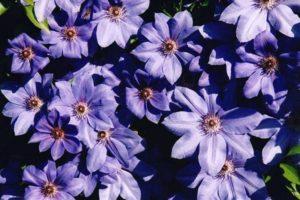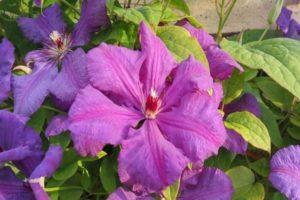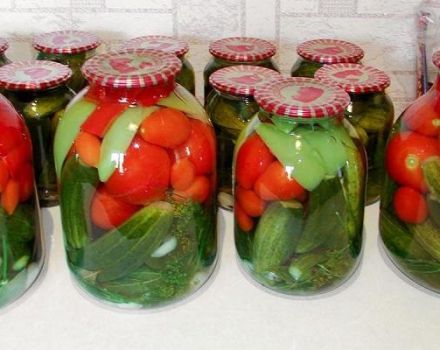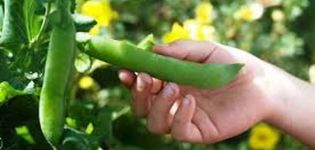Description of clematis varieties de Boucher, planting scheme and care
The exquisite and luxurious flowers have always attracted special attention. Seeing a wall of clematis flowers in front of you, rarely anyone is able to remain indifferent. Among their varieties, some do not require complex care and are available for growing to beginners. These are the flowers of clematis de Bouchaud.
Description and features of clematis
The stem of the comtesse de bouchaud is a liana 3-4 meters long. When this flower is grown in Russia, it has a smaller size - 2-3 meters.
The leaves of this plant have a complex shape. They are dense, consisting of five pointed ovate leaflets. Peduncles are long, they can reach 18 centimeters. Flowers have a diameter of 10-15 centimeters. A large number of flowers bloom on one stem.
Clematis is not a double flower. It has 6 elliptical sepals. The color of this variety is pink with a purple tint. The petals appear corrugated with streaks of a deeper purple. The color of the stamens is bright yellow.
A flower can produce seeds, but it will not work to grow flowers from them. In conditions of bright sunlight, flowers do not burn out.
The flowering period is from July to September.
Flower formation occurs almost along the entire length of the plant: the lowest flowers are located at a height of 20-25 centimeters along the entire length of the plant's shoots.
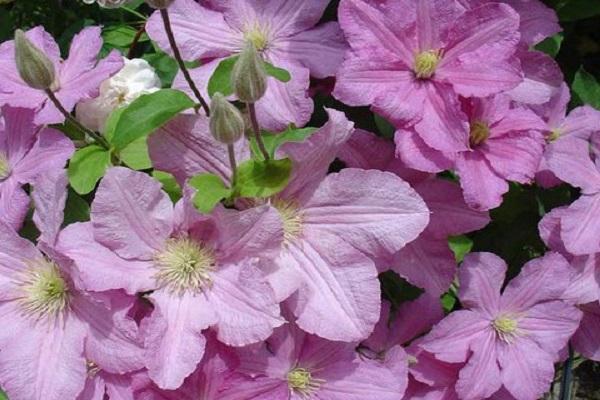
The lifespan of clematis de Boucher is 20 years.
The history of the comtesse de bouchaud
This species is one of the most prominent in the Clematis family. The Comtesse de Bouchaud has a history that goes back over a hundred years.
It was bred by the French florist Francis Morel. This variety has received an award from the Royal Horticultural Society. It owes its name to the Countess de Bouchot, famous for her luxurious garden in Chassel in southeastern France.

Growing
Although this flower is unpretentious, the planting procedure must be carefully considered. This plant lives for a long time and therefore it is better to do everything right at once than to correct the mistakes made later.
Planting dates for clematis
The time for planting seedlings may be late spring or early autumn. However, there are important features here:
- When planted in spring, flowers have more room to grow and take root before winter comes. However, when planting, you need to take care of the roots, since they can be easily damaged at this time.
- In the fall, you need to plant no later than a month or two before the onset of the first frost. This is necessary due to the fact that in order to successfully survive the winter, Clematis needs time. However, when planted in autumn, seedlings take root easier than in spring.
In some cases, you can plant a seedling during the summer. This is done in cases where it has a closed root system.
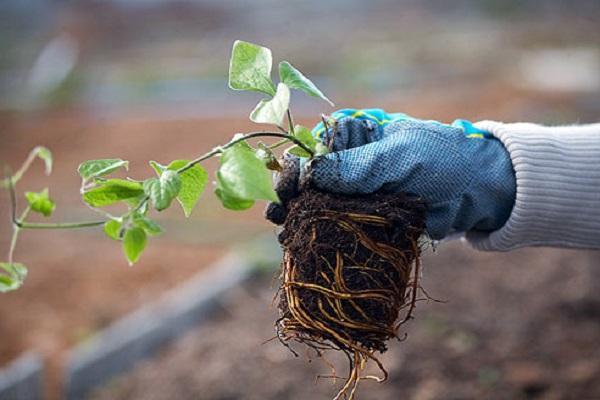
Seat selection
So that Clematis de Bouchaud develops well. the landing site must meet the following conditions:
- The plant loves when there is a lot of sunshine throughout the day. Shading is allowed, provided that it lasts no more than half of the daytime.
- There should be no draft or strong wind where these flowers grow.
- It is necessary to take into account the depth of the groundwater. They should not be too close to the surface. If this condition cannot be met, an additional embankment is made for flowers at least 15 centimeters high.
- It is necessary that there is no fence or wall of the house closer than 50 centimeters.
It is necessary to make sure that the water does not drain from the roof on the flowers in rainy weather.
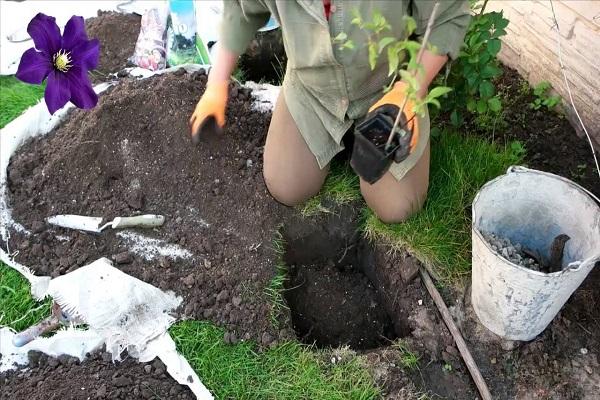
Soil preparation
The soil must be well permeable to air and fashion. Clematis loves when it has enough nutrients to grow.
Avoid acidic soils. If there are no other possibilities, then you can use them provided that wood ash or lime is added.
Selection and preparation of planting material
In order for the plant to grow healthy, you need to choose the most suitable seedlings. To do this, it is recommended to be guided by the following:
- You need to carefully examine them and make sure there are no mechanical damages.
- If there are traces of diseases, it is better not to use such seedlings.
- On a shoot with a length of 5 centimeters, at least two buds are required. They must be unblown.
The total length of the roots cannot be less than 50 centimeters. The number must be at least five.

Landing scheme
It is recommended to prepare pits for planting clematis in advance - a few weeks before. Width, length and depth should be 60 centimeters.
It is important to properly prepare the planting mixture. For it you need to use the following:
- It is necessary to take in equal parts earth and humus.
- For each pit 3-4 kilograms of sand, 400 grams of dolomite flour and 150 grams of superphosphate are added.
A small mound of the prepared mixture is poured into the pit before planting. The roots of the seedling are carefully straightened, placed in the prepared hole and the rest of the planting mixture is poured.
It is recommended to fill the ground so that the root collar is underground. The recommended depth is 5-15 centimeters. However, in the northern regions, a different landing strategy is needed. Here, the root collar is not buried, but a layer of mulch is poured onto the ground.
Before planting, you need to install clematis supports. At first, the plant needs to be tied to them. In the future, he will begin to cling to them himself.
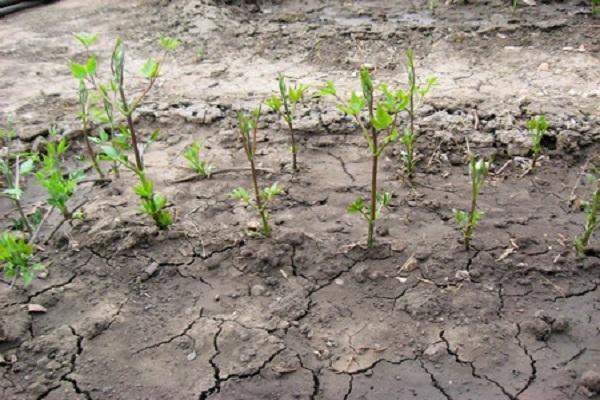
Care rules
Only with proper care can you expect to see the luxurious flowering of Clematis. Its rules are set out below.
Watering
If the flower does not receive enough water, the inflorescences will be sparse and small. The flowering period may be reduced due to this.
If the weather is hot, watering at least 2-3 times a week is enough. In this case, it is necessary to ensure the irrigation of the leaves. Watering is performed after sunset.

Loosening and weeding
It is important to loosen it after watering so that the soil does not form a solid crust. Weeding is done in order to get rid of weeds as they appear.
Mulching
If the plant is mulched with a thick layer of organic material, then the amount of watering can be reduced.
Clematis roots do not tolerate heat well.Therefore, mulching will be a good protection against overheating for them.
Pruning
It is necessary to monitor the appearance of dried, sick or damaged shoots. If they appear, you need to cut them off.
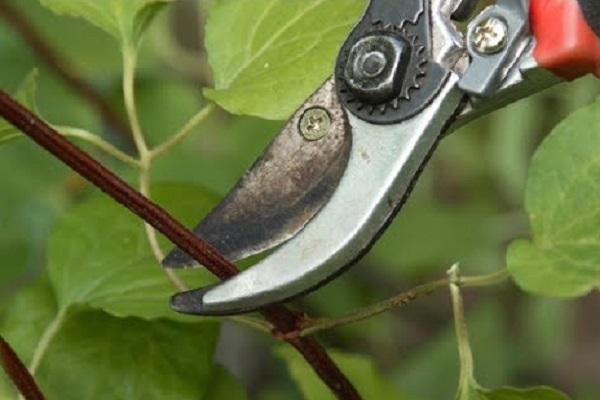
Shelter for the winter
When pruning Clematis for the winter, the roots are covered with a thick layer of peat or humus. It is recommended to cover the top with an inverted wooden box or plastic container. It is recommended to cover the top with sawdust or dry leaves. Additionally covered with non-woven material.
In the spring, you need to remove the covering layer in time. If you don't. then the flower may overheat. The best option is to gradually remove the cover over several weeks.
Protection against diseases and pests
For Clematis, wilting or wilt is the most dangerous disease. It is often caused by a gross violation of the landing rules.
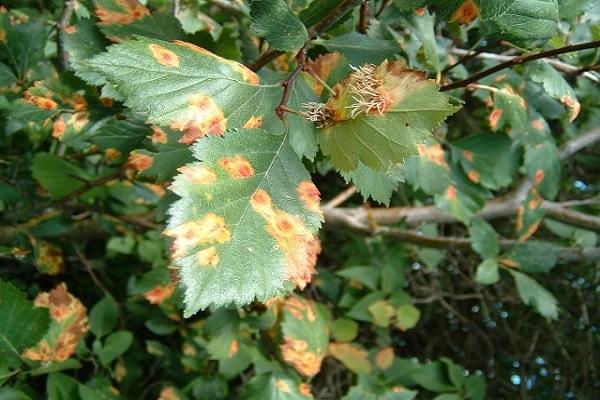
A mixture of sand and wood ash is effective as a prophylactic agent. Sprinkle the roots with this composition. Additionally, you can spray the plant with Fitosporin. This can be done several times.
Spraying with PhytoFerm will help protect Clematis from most types of insect pests.
Reproduction
There are several ways. with which you can reproduce plants. Each of them has its own characteristics.
Cuttings
To do this, you need to cut cuttings 6 centimeters long from the central part of the plants. It is important to make sure they have at least two kidneys on them. The cut site is treated with Kornevin. Cuttings are planted in a mixture of sand and peat and watered abundantly.
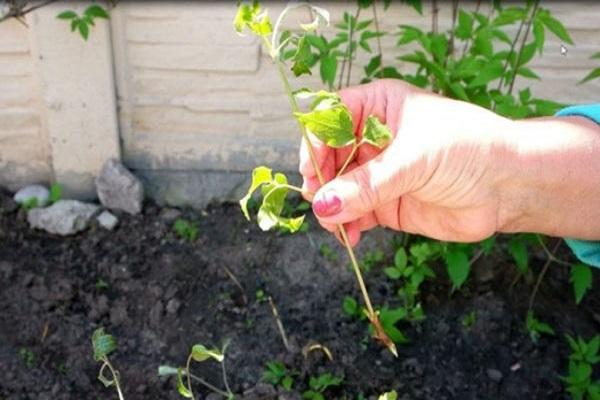
Seeds
This method has the lowest germination rate. It is used only in cases where it is necessary to preserve the specific characteristics of the plant. With other methods of propagation, they will not be inherited from the parent plant.
Dividing the bush
The most effective division of bushes at the age of 5-7 years. This can be done in spring or fall. To do this, you need to dig in the root and separate the appropriate part of it.
Layers
In order to propagate a flower in this way, you need to place the branch in a groove 6-8 centimeters deep and lightly sprinkle it with earth. In this case, the tip of the shoot 20-25 centimeters long is left on the surface.

Use in landscape design
As a climbing plant, Clematis can be used for vertical gardening.
It will look good as a decoration for gazebos, arches, fences, fences, walls of houses. Clematis can also be used to decorate old trees.
Reviews
Clematis de Bouchaud was highly appreciated by many growers. The following are the reviews of experts.
Julia, Krasnodar
This is one of my favorite species. The flower was grown from a cuttings, after rooting it. For the second season in my flower garden, the most abundant flowering can be seen in this bush. He easily survived the extreme heat, in which the temperature reached 40 degrees. Clematis tolerates frost well. I can admire its flowering from the beginning of June to the end of September.
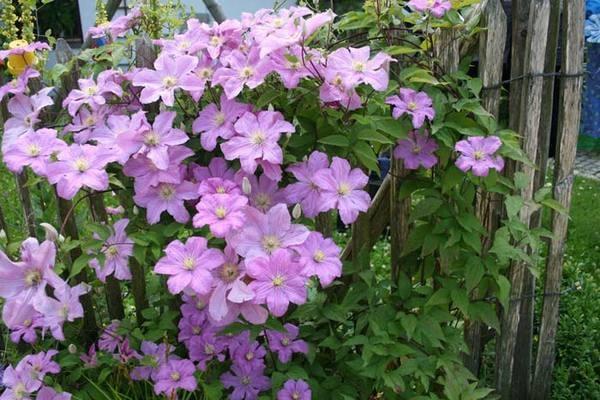
Larisa, Kiev
The third season I grow Clematis de Busho. Planted on the advice of friends as an unpretentious variety, known for its vitality. I was amazed at how beautiful he is. The flowers have a delicate pink color, the petals have a wavy edge. The bloom is profuse and lasts a very long time.
Tatiana, Kolomyia
Comtes de Bouchaud is liked by the abundance of flowering and the fact that flowers grow on it from the ground to the very top. I consider this species to be the most beautiful of clematis.
